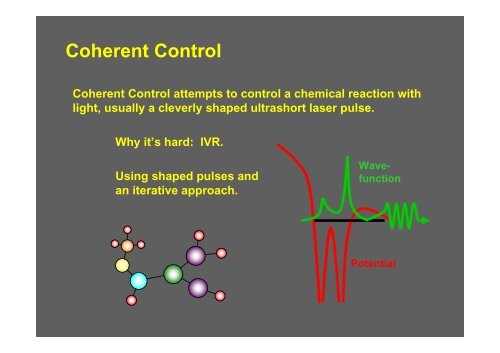Coherent Control
Coherent Control
Coherent Control
You also want an ePaper? Increase the reach of your titles
YUMPU automatically turns print PDFs into web optimized ePapers that Google loves.
<strong>Coherent</strong> <strong>Control</strong><strong>Coherent</strong> <strong>Control</strong> attempts to control a chemical reaction withlight, usually a cleverly shaped ultrashort laser pulse.Why it’s hard: IVR.Using shaped pulses andan iterative approach.WavefunctionPotential
<strong>Coherent</strong> <strong>Control</strong>Chemical reactions proceedin a manner determined bythe molecular Hamiltonian.What if we’d like to change this and make different products?Bring in a light frequency to excite a bond we’d like to break. But it’snot so easy! There’s a lot more to it.A long-held dream of chemists. It’s now coming true. Shapedultrashort pulses are the key.<strong>Coherent</strong> control slides mostly thanks toGustav Gerber, University of Wurzberg, GermanyMargaret Murnane and Henry Kapteyn, JILARobert Levis, Temple University
Conventional methods of chemicalcontrolC = catalystMuch can be done, but not everything we’d like.
Intramolecular Vibrational RedistributionExcite one bondThe bondvibratesA few fs later,however, theentire molecule isvibrating.IVR occurs on a few-fs time scale, so long pulses excite entire molecule,and the weakest bond breaks, no matter which bond was excited.
Single-parameter controlSurprisingly, these simple methods often work, but they are not general.
<strong>Coherent</strong> control: Using shapedultrashort pulses to control the reactionCan an ultrashort pulse cause a molecule to vibrate in such away as to break the bond of our choice?
The physics of coherent controlThe pulse electric field perturbs the molecule and potentiallydissociates it.MoleculeE-fieldof LaserPerturbed SystemWavefunctionWavefunctionPotentialPotentialThe trick is to compute the required pulse electric field.
Trying to do the theory for coherent controlFirst, we need to know the complete Hamiltonian for the moleculeand radiation:H system = H molecule + H radiation + H interactionH radiationknownweak field: knownψ μ⋅E ψfiH interactionH moleculestrong field: unknownsmall molecules: approximatelarge molecules: unknownIt’s hopeless to solve the problem for all but the simplest molecules.
We could try to solve the problem theoretically,but it’s easier to just do it iteratively in the lab.
Pulse-shaping is important for coherentcontrol.
Genetic algorithm for coherent controlThis algorithm was developed for computer optimization, but, forcoherent control, it can be implemented as part of an experiment.
A genetic algorithm can minimize the pulselength.
Using a learning algorithm to performcoherent control
<strong>Coherent</strong> control of a simple gas phasereactionReaction under studyCO 2 CCl 4 Shaped PulseCCl 2 OMurnane andKapteyn,University ofColorado
<strong>Coherent</strong> control with acetone (gas phase)Acetone can be broken into various pieces. A laser pulse could help.Normalized ion signal2520151050Levis and coworkersMass spectrum=H 3 C - C - CH 3+M-30 +M-15 +H 2O+CH + +O 2+C ++CH 3+0 10 20 30 40 50Mass, amuO(Acetone)60H 3 COCH 3 COC+OCCH 3CH 3CH 3+ +H 3 C
Optimizing one acetone photo-fragmentGoal: Optimize CH 3 CO + at 43 amuAcetoneNormalized Ion Intensity6040200CH 3 CO +221030generation10203040506070Mass (amu)Levis and coworkersScience 2001, 292, 709
Maximization of the relevant photofragmentoccurs rapidly.100CH 3 CO + Signal80604020O=H 3 C - C - CH 3CH 3 CO + CH 30510152025Generation NumberLevis and coworkersScience 2001, 292, 709
Manipulating the dissociation yields inacetophenoneNormalized ion intensity and ratioDifferent pulse shapes can optimize differentphoto-fragments.1.61.41.21.00.80.60Levis and coworkersRatio:C 7 H 5 O/C 6 H 5510Generation1520OC++OCCH 3CH 3OCCH 3
Reversing the ratio: Increasing the phenylyieldNormalized ion intensity and ratio2.22.01.81.61.41.21.0Optimizing the phenyl fragmentyield also works.100 kcal/mole O 85 kcal/mole0Ratio:C 6 H 5 /C 7 H 5 O510 15Generation20+OC+COCCH 3CH 3CH 3Levis and coworkers
What do these pulses look like?The pulse that maximizes the ratio of the two fragments.Interestingly, a very simple pulse maximizes the phenyl radical(but not the ratio).OCCH 3Levis and coworkersO+enhancesuppressC+OCCH 3CH 3420Wavelength (nm)SHG FROG trace395-150 -75 0 75 150Delay (fs)
Molecules are not isotropic, so pulsepolarization shaping is important.inputpulseto POLLIWOG apparatus
A complex polarization-shaped pulse
<strong>Coherent</strong> polarization control of acomplex molecule in the gas phaseGerber and coworkers
<strong>Coherent</strong> control is here!It works, not only in the gas phase, where dephasing times arelong, but also in the liquid phase. This is potentially very useful!Almost any wavelength will do, as high intensity broadens theenergy levels significantly, making all processes effectivelyresonant.Rabitz has shown that it is robust and should occur foressentially all systems.By determining the precise field that optimizes the desiredproduct, we also learn about the molecule.<strong>Coherent</strong> control has applications far beyond chemistry.
Successful closed-loop coherent controlexperiments in physics and chemistry(1) Fluorescence spectrum manipulation (Wilson, 1997)(2) Atomic excitation tailoring (Bucksbaum, 1999)(3) Vibrational excitation tailoring in polymers (Motzkus, 2002)(4) Molecular fragmentation selectivity (Gerber, 1998; Levis & Rabitz, 2001)(5) Molecular rearrangement selectivity (Levis & Rabitz, 2001)(6) Chemical discrimination (Gerber, 2001)(7) High harmonic X-ray tailoring (Murnane & Kapteyn, 2000)(8) Ultrafast solid-state optical switching (Keller, 2000)(9) Distortion-free transmission of pulses in optical fibers (Omenetto, 2001)(10) Decoherence management (Walmsley, 2002)(11) Photosynthetic bacteria energy transfer (Herek and Motzkus 2002)By 2003, ~ 50 systems have been successfully controlled.


